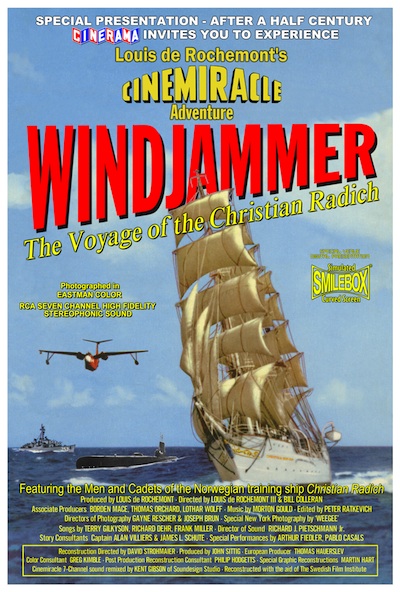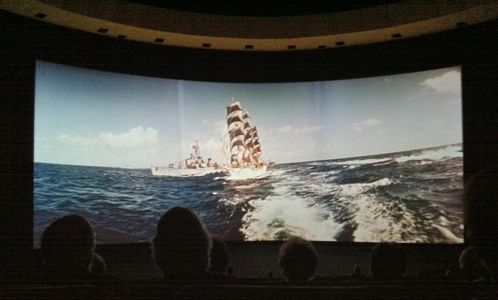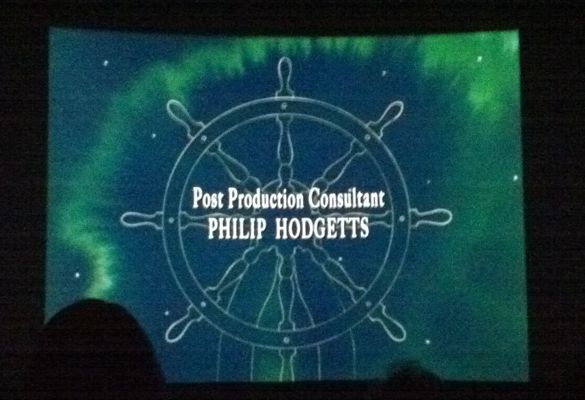Â

Â
Was at the Cinerama Dome to view the restored print of Windjammer and it occurred to me that there’s a lot of commonality between Cinerama (the three camera/three projector widescreen of the late 50’s and early 60’s) and 3D.
But first, a little back story. I have been consulting on the restoration of Windjammer as a technical consultant: making sure that the maximum amount of quality we could get from the print was available for the restoration.
I also advised on tools for the job. The Foundry’s Furnace Core featured prominently as did Adobe After Effects and Final Cut Pro. I also helped set workflow and kept everything running smoothly.
Unfortunately the complete negatives for the three panels of Windjammer are not complete. In fact the only place the entire movie is available was in a badly faded composite 35mm Anamorphic print.
You can see the trailer, remastering process and how we telecined (Oh look, it’s me in the telecine bay) online, but today was the only time it’s likely to be shown in a Cinerama Theater.
David Strohmaier and Greg Kimble did a great job on the restoration – all on Macs with Final Cut Pro and After Effects.
Now this wasn’t a full reconstruction so we worked in HD – 1080p24 – but used the full height during telecine and correction so we didn’t waste any signal area with black. For the DVD, due in early 2011, the aspect ratio is corrected and a “smile box” (TM) treatment to simulate the surround nature of Cinerama.
Because we were working in HD, I was pleasantly impressed by how great it looked at Cinerama size on the Arclight Theater’s Dome Cinema in Hollywood. (Trivia point: the Dome was built for Cinerama it never showed Cinerama until this decade.)
Another point of interest was that the whole show ran off an AJA KiPro as it did in Bradford earlier in the year, and Europe last month. Each Act of the 140+ minute show was contained on one drive pack. Can’t recommend the KiPro highly enough.
So, there we were enjoying the story (and restoration work) and it occurred to me that there were strong similarities in cinematic style between “made for 3D” 3D and Cinerama.
Â

Â
Cinerama seams together three projectors into a very wide screen view that was the precursor of modern widescreen. The very wide lens angles favor the big, panoramic shots and shots that are held rather than rapid cutting. Within this frame the viewer’s eyes are free to wander across multiple areas of interest within the frame.
Similarly, my experience of “made for 3D” 3D movies is that it is most successful when shots are held a little bit longer because each time a 3D movie makes a cut, it takes the audience out of the action for a moment while we re-orient ourselves in space. (Unfortunately there’s nothing analogous to that in the Human Visual System, unlike traditional 2D cutting, which mimics the Human Visual System – eyes and brain together .)
Both Cinerama and 3D work best (in my humble opinion) when the action is allowed to unfold within the frame, rather than the more fluid camera of less grand 2D formats or 3D.
Since 3D had its last heyday around the same time as Cinerama, maybe everything old is new again? Digital Cinerama anyone? (How will we sync three KiPros?)
And one little vanity shot since today was the first (and likely last) time I’ve had my credit up on the big screen in a real cinema:
Â

Â
Â
One reply on “What do Cinerama and 3D have in common?”
Congratulations Philip, and thank you for your efforts in bringing this wonderful piece of cinema history back to the screen. I last saw this film when I was about 8 years old at Grauman’s Chinese theater in 1958, and when we attended a screening of “How The West Was Won” in Cinerama a couple of years ago, I remember thinking what an impossible dream it would be to see Windjammer once again. While it was not the high resolution of the 3-strip version of my youth, it was a fabulous journey to the past, and you guys did a terrific job given the poor quality of the print and limited budget. Kudos!